Museum of the Manchester Regiment
History
Territorial Force 1914 - 1919
- 1/5th Battalion The Manchester Regiment (TF)
- 1/6th Battalion The Manchester Regiment (TF)
- 1/7th Battalion The Manchester Regiment (TF)
- 1/8th Battalion The Manchester Regiment (TF)
- 1/9th Battalion The Manchester Regiment (TF)
- 1/10th Battalion The Manchester Regiment (TF)
- Second Line Territorial Force Battalions 1914 - 1919
- 2/5th Battalion The Manchester Regiment (TF)
- 2/6th and 2/7th Battalions The Manchester Regiment (TF)
- 2/8th Battalion The Manchester Regiment (TF)
- 2/9th Battalion The Manchester Regiment (TF)
- 2/10th Battalion The Manchester Regiment
- Third Line Territorial Force Battalions 1914 - 1919
- 3/5th, 3/6th and 3/7th Battalions The Manchester Regiment
- 3/8th, 3/9th and 3/10th Battalions The Manchester Regiment
1/5th Battalion The Manchester Regiment (TF)
Mobilised at Wigan 4 August 1914 as one of the four battalions of the Manchester Brigade (later numbered 127 Brigade) of 42 Division. 10th September sailed from Southampton for Egypt, arriving Alexandria 25 September 1914. To Gallipoli 9 May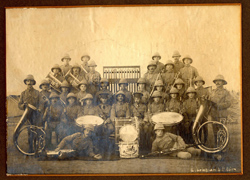 1915. Krithia - June 1915. Achi Baba Mullah & Krithia Vineyards - August 1915. Withdrew from Gallipoli on 9 January 1916.
1915. Krithia - June 1915. Achi Baba Mullah & Krithia Vineyards - August 1915. Withdrew from Gallipoli on 9 January 1916.
To Egypt. August the Battle of Rumani. Katia. El Arish. Moascar. To France 2 March 1917 disembarking Marseilles 9 March. 11 March Pont Remy. 12 March Cerisy Buleux. 31 March outside Peronne. 28 April in reserve line at Ypres. 9 July Bapaume. 21 August Bozencourt.
February 1918 to 126 Brigade. Stationed in Halluin on 10 May and on the11th moved to Obigies, 4 miles north of Tournai. On the 11th Tournai was repeatedly bombed. On the 13th the battalion moved to Lys les Annoy, over the border in France. Later returned to Obigies later moved into the front line on the Le Marque River between Anstang and Gruson. In November 1918 near Hautmont.
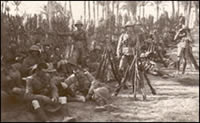 1/6th Battalion The Manchester Regiment (TF)
1/6th Battalion The Manchester Regiment (TF)
Mobilised at Stretford Road Barracks, Manchester on 4 August 1914. Then as the 1/5th Battalion.
On the 11th November 1918 the 6th Battalion were in the Forest of Mormal, near to the hamlet of Hagnies, billeted in the Municipal school at Hautman. During the third week of December the battalion presented a carved oak memorial plaque to the village that was placed in Hagnies church where it remains to this day. Private H L Jones carved the plaque and the inscription painted by Private C C Farmier.
The war memorial to the dead of WWI of the 6th Battalion was unveiled in the Stretford Road Drill Hall on 12 June 1921. It consisted of seven polished dark-oak panels, six of which contain in gold lettering the names of the 1,057 officers and men of the battalion who laid down their lives. The seventh panel contains in illuminated text the inscription of the memorial headed by the words ‘The Glorious Dead'. Following the demolition of the drill hall and its replacement by University Barracks in 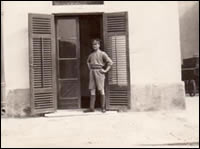 1995, the memorial panels were cleaned and installed in the new building.
1995, the memorial panels were cleaned and installed in the new building.
At the end of the war a bronze memorial plaque to the memory of those members of the 1/6th Battalion who had laid down their lives in Egypt and Gallipoli was erected in the Chapel in Mustapha Barracks, Alexandria. In 1946 with the evacuation of British Troops from Egypt, the memorial was sent to England and is now located in University Barracks, Manchester, the original home of the 6th Battalion.
1/7th Battalion The Manchester Regiment (TF)
Mobilised at Burlington Street Barracks, Manchester on 4 August 1914. Then as the 1/5th and 1/6th Battalions.
The 7th Battalion War Memorial is located in Whitworth Park, Oxford Road, Manchester that is within the old recruiting area of the battalion. Designed by Norman Wragge as the result to a competition held by Professor A C Dickie Chair of Architecture at Manchester University and his pupils. The memorial is a tapered column of Westmoreland Elterwater black granite, standing on a base of white stone. A floriated fleur de Lys, as worn by the 7th Battalion, is cut out on each of the four sides. The Honorary Colonel, General Sir Reginald Wingate, unveiled it in September 1933.
Permission for the erection of the memorial had been given by the Whitworth Trustees and approved by Manchester City Council. The memorial replaced the original war memorial, which was on the wall within the Burlington Street Headquarters. Prior to the sale of the old drill hall it was felt better to have it carefully obliterated in order that no indignity could happen under future owners.
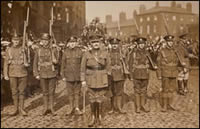 1/8th Battalion The Manchester Regiment (TF)
1/8th Battalion The Manchester Regiment (TF)
Mobilised at Ardwick Barracks, Manchester on 4 August 1914. Then as the 1/5 th, 1/6 th and 1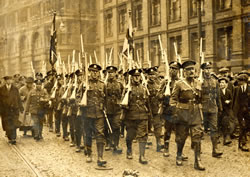 /7 th until February 1918. Then to 126 Brigade. Continued in action until the end of the war near Hautmont.
/7 th until February 1918. Then to 126 Brigade. Continued in action until the end of the war near Hautmont.
The name of Lieutenant John William Womersley of the 8th Battalion is to be found in the memorial chapel in St John's Chryostoms Church, Anson Road, Manchester.
1/9th Battalion The Manchester Regiment (TF)
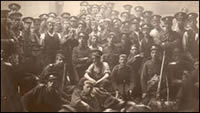 Mobilised 4 August 1914 at Old Street, Ashton under Lyne as one of the four battalions of the East Lancashire Brigade. Then as the 1/5 th, 1/6 th, 1/7 th and 1/8 th to 19 February 1918 when it absorbed the 2/9 th Battalion. April 1918 reduced to a training cadre. 22 July 1918 to 199 Brigade 66 Division. 13 August 1918 absorbed 13 th Manchester 's and reconstituted as 9 th Battalion. Finished the war at Soire le Chateau, east of Avesnes.
Mobilised 4 August 1914 at Old Street, Ashton under Lyne as one of the four battalions of the East Lancashire Brigade. Then as the 1/5 th, 1/6 th, 1/7 th and 1/8 th to 19 February 1918 when it absorbed the 2/9 th Battalion. April 1918 reduced to a training cadre. 22 July 1918 to 199 Brigade 66 Division. 13 August 1918 absorbed 13 th Manchester 's and reconstituted as 9 th Battalion. Finished the war at Soire le Chateau, east of Avesnes.
1/10th Battalion The Manchester Regiment (TF)
Mobilised at Rifle Street Barracks, Oldham on 4 August 1914.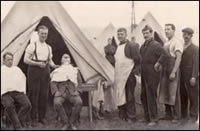 (Lieutenant Colonel R Lewis, the commanding officer killed in action on 7 September 1917) Then as the 1/9 th Battalion until February 1918 when the battalion remained in 42 nd Division and transferred, with the 8 th Battalion, to 126 Brigade. March 1918 - Goniecourt. Finished the war near Hautmont.
(Lieutenant Colonel R Lewis, the commanding officer killed in action on 7 September 1917) Then as the 1/9 th Battalion until February 1918 when the battalion remained in 42 nd Division and transferred, with the 8 th Battalion, to 126 Brigade. March 1918 - Goniecourt. Finished the war near Hautmont.
Two bronze memorial tablets were unveiled in the Oldham Town Hall in 1921. The inscriptions set out the achievements of the 10th and 24th Battalions in the war. They were unveiled by Major General G H Shoubridge DB CMG DSO. These are now located in the Civic Centre, Oldham together with the silver and colours of the 10th Battalion. The silver drums are the War Memorial of the battalion and the names of all those killed are engraved on the drums.
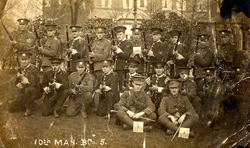 Busk Wood, Little Langdale, Cumbria contains a plain memorial stone to 2nd Lieutenant James Denton Lee of the 10th Battalion. He died from his wounds on 22 January 1918 and is buried in Lister Lane Cemetery, Halifax.
Busk Wood, Little Langdale, Cumbria contains a plain memorial stone to 2nd Lieutenant James Denton Lee of the 10th Battalion. He died from his wounds on 22 January 1918 and is buried in Lister Lane Cemetery, Halifax.
A memorial to the men of the 42nd Division who gave their lives in the attack and capture of the Hindenburg Line at Trescault on 28 September 1918 was erected in Trescault in 1920. Another memorial to the 42nd Division is to be found in Bucquoy, the scene of violent fighting early in 1918.
Second Line Territorial Force Battalions 1914 - 1919
The Second Line Battalions were formed in September 1914, after the First Line had sailed for Egypt. Those of the First Line who were left behind formed a nucleus for each new Second Line Battalion, roughly between one hundred and two hundred men for each new battalion. Recruits were called for and within a week practically all these new battalions were at full strength.
By March 1918 the 2/5th, 2/6th and 2/7th Battalions were the surviving battalions in 199 Brigade of 66 Division, part of the 5th Army. All acquitted themselves well when the German final offensive was launched on 21 March 1918 but were so severely decimated that by April they had been reduced to token cadre strength. They were all disbanded on 31 July 1918.
2/5th Battalion The Manchester Regiment (TF)
Formed at Wigan during September 1914. November 1914 to 199 Brigade, 66 Division. Trained at Southport until May 1915, then to Crowborough, Cuckfield and Peaspottage in Sussex. March 1916 to Colchester. March 1917 to France and active service on the Western Front. April 1918 reduced to training cadre. 31st July 1918 disbanded in France.
2/6th and 2/7th Battalions The Manchester Regiment (TF)
Formed at Manchester during September 1914. November 1914 to 199 Brigade, 66 Division. Trained at Southport until May 1915, then to Crowborough, Cuckfield and Peaspottage in Sussex. March 1916 to Colchester. March 1917 to France and active service on the Western Front. 24 June - 26 September 1917 to coastal sector at Nieuport as part of the force required to mount local operations in the overall Third Ypres plan. 9 October 1917 Battle of Poelcapelle, Paschendaele. 30 March 1918, 66 Division withdrawn from front line & moved to Amiens. April 1918 both battalions reduced to training cadre and on 31 July 1918 disbanded at Havrincourt. The cadres joined the 1/6th and 1/7th Battalions. A stained glass memorial window to Joseph Norman Rostern 2/7th Battalion, killed in action 28 March 1918 at Peronne, is situated in Holy Trinity Church, Northwood, Middlesex.
2/8th Battalion The Manchester Regiment (TF)
Formed at Ardwick, Manchester during September 1914. November 1914 to 199 Brigade, 66 Division. Trained at Southport until May 1915, then to Crowborough, Cuckfield and Peaspottage in Sussex. March 1916 to Colchester. March 1917 to France and active service on the Western Front. Commanding Officer Lieut Colonel K R Balfour and the Adjutant Captain G McDougall.
April and May were spent alternating between the front line in the Cambrin Right Sector and Brigade Reserve at Noyelles - 4 days on and 4 days off. June began in much the same way. 2nd Lieutenant Bowker of A Company wounded on 9 June; 2nd Lieutenant J P Bruce wounded on 18 June and 2nd Lieutenant Irlam killed on 20 June.
21 June to Bevry and on in motor transport to La Pugnoy where they were billeted. Left La Pugney and entrained at Choques, then marched to St Pol. Most of July spent as working parties moving shells. On night of 30/31 July the battalion took over the Right Sub-Sector at Nieuportbains.
The first two days of October were spent training in the Renescure area. On 3 October marched to Arques and then by train to Brandhoei where they spent the night in huts at Erie Camp. The next evening marched off at 7.30pm for Ypres south and accommodated in ruined houses in Vlamertingue. The following day, after a difficult march in stormy conditions, relieved the 37th and 38th Regiments Australian Infantry in support sector. 7 October relieved the right front battalion of 49th Division. No continuous trench system. Front line troops had to occupy shell holes without any overhead cover.
8 October Considerable shelling particularly around battalion HQ. 9 October assaulting battalions moved up to assembly area in early morning. Battalion had to cover a front of 800 yards. 82 casualties. Battalion relieved late evening of 10 October by 41st Regiment Australian Infantry.
11 October spent in resting at Eric Camp, Brandhoek. A further 33 casualties that day due to extensive enemy shelling of the battalion area.
April 1918 reduced to training cadre. 31st July 1918 disbanded in France. Drafts sent to 2/5th, 2/6th and 2/7th Battalions.
The War Diary of the 2/8th Battalion beginning April 1917 is held in the Archive Collection as are documents relating to individuals
2/9th Battalion The Manchester Regiment (TF)
Formed at Ashton under Lyne during September 1914. November 1914 to 199 Brigade, 66 Division. Remained in Lancashire until about May 1915, then to Crowborough. February 1917 to France and active service. 19 February 1918 absorbed into 1/9th Battalion.
2/10th Battalion The Manchester Regiment
Formed at Oldham during September 1914. Then as the 2/9th until disbandment in France on 15th February 1918.
A memorial to the 66th Division in which the six-second line battalions served is in the form of a stained glass window in the church at Passchendaele and commemorates particularly those who fell in the battle of October 1917. The overall colour of the window is yellow-light green with details in red.
Third Line Territorial Force Battalions 1914 - 1919
The Third Line (or Reserve) Battalions were formed for the purpose of sending drafts to the First and Second Line Territorial Battalions. They relied heavily on the sick and wounded officers and NCOs from the First Line Battalions as they filtered back to these Reserve Battalions after leaving hospital.
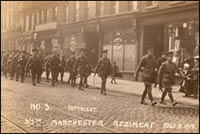 3/5th, 3/6th and 3/7th Battalions The Manchester Regiment
3/5th, 3/6th and 3/7th Battalions The Manchester Regiment
Formed at Wigan (5th Battalion) in May 1915 and Manchester (6th and 7th Battalions) in March 1915. Early in 1916 to Witley, Surrey and on 8 April 1916 became Reserve Battalions. On
1 September 1916 the 5th (Reserve) Battalion absorbed the 6th and 7th. Now became part of the East Lancashire Reserve Brigade. To Southport in October 1916. To Ripon in January 1917. To Scarborough in July 1917 where it remained until disbandment in 1919.
3/8th, 3/9th and 3/10th Battalions The Manchester Regiment
Formed at Ardwick, Ashton under Lyne and Oldham in March 1915. Early in 1916 to Witley, Surrey and on 8 April 1916 became Reserve Battalions. 1 September 1916 the 8th (Reserve) Battalion absorbed the 9th and 10th (Reserve) Battalions. Now became part of the East Lancashire Reserve Brigade. To Southport in October 1916. To Ripon in January 1917. By July 1917 in Hunmanby and in April 1918 to Filey where it remained until 1919.

